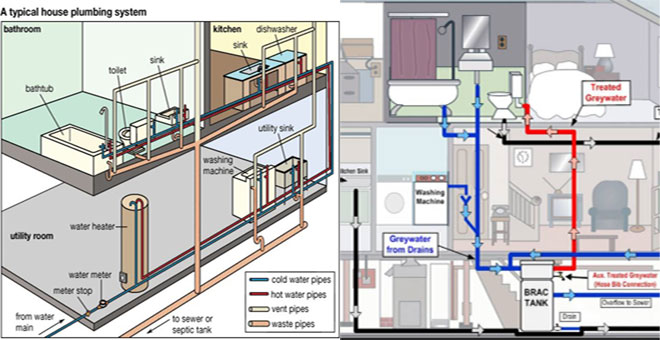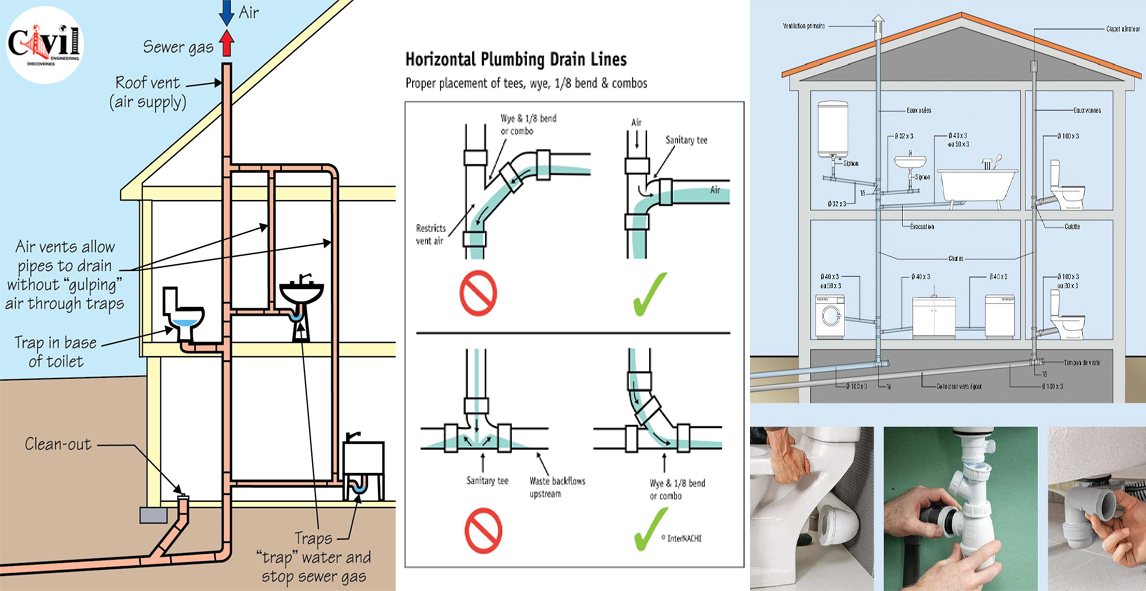The Layout of Your House's Plumbing System Explained
The Layout of Your House's Plumbing System Explained
Blog Article
We have uncovered this article on Plumbing Installation 101: All You Need to Know down the page on the web and believe it made perfect sense to share it with you in this article.

Comprehending how your home's plumbing system works is crucial for every house owner. From delivering clean water for alcohol consumption, cooking, and bathing to safely eliminating wastewater, a properly maintained pipes system is essential for your household's health and comfort. In this detailed overview, we'll check out the complex network that composes your home's pipes and offer suggestions on maintenance, upgrades, and managing usual problems.
Introduction
Your home's pipes system is greater than just a network of pipelines; it's a complex system that ensures you have access to clean water and effective wastewater removal. Understanding its parts and just how they work together can help you protect against costly repairs and guarantee whatever runs efficiently.
Standard Elements of a Pipes System
Pipes and Tubing
At the heart of your plumbing system are the pipes and tubing that carry water throughout your home. These can be made of various products such as copper, PVC, or PEX, each with its benefits in regards to longevity and cost-effectiveness.
Components: Sinks, Toilets, Showers, and so on.
Components like sinks, commodes, showers, and bathtubs are where water is used in your home. Understanding how these fixtures attach to the pipes system aids in diagnosing problems and intending upgrades.
Shutoffs and Shut-off Factors
Shutoffs manage the flow of water in your plumbing system. Shut-off valves are essential during emergency situations or when you require to make fixings, permitting you to separate parts of the system without interfering with water circulation to the entire house.
Water Supply System
Key Water Line
The major water line links your home to the metropolitan water system or a personal well. It's where water enters your home and is distributed to various components.
Water Meter and Stress Regulator
The water meter measures your water usage, while a stress regulatory authority guarantees that water flows at a secure stress throughout your home's plumbing system, avoiding damage to pipelines and components.
Cold Water vs. Warm water Lines
Recognizing the difference between cold water lines, which supply water straight from the primary, and hot water lines, which carry warmed water from the hot water heater, assists in fixing and preparing for upgrades.
Drain System
Drain Pipes Piping and Traps
Drain pipelines carry wastewater away from sinks, showers, and toilets to the sewer or septic system. Catches protect against sewage system gases from entering your home and likewise trap particles that could cause obstructions.
Ventilation Pipes
Air flow pipelines allow air into the drain system, preventing suction that might slow drainage and cause catches to vacant. Correct ventilation is vital for maintaining the stability of your plumbing system.
Relevance of Appropriate Drain
Ensuring correct water drainage prevents backups and water damages. Routinely cleansing drains and preserving catches can avoid pricey fixings and extend the life of your plumbing system.
Water Furnace
Kinds Of Hot Water Heater
Water heaters can be tankless or standard tank-style. Tankless heating units heat water on demand, while containers store warmed water for instant usage.
Updating Your Pipes System
Reasons for Updating
Upgrading to water-efficient components or replacing old pipelines can boost water quality, minimize water costs, and increase the value of your home.
Modern Plumbing Technologies and Their Benefits
Check out innovations like clever leakage detectors, water-saving toilets, and energy-efficient water heaters that can save cash and lower ecological impact.
Cost Factors To Consider and ROI
Calculate the upfront costs versus long-lasting savings when considering plumbing upgrades. Many upgrades pay for themselves via reduced utility expenses and less repairs.
How Water Heaters Link to the Plumbing System
Comprehending exactly how hot water heater attach to both the cold water supply and warm water distribution lines assists in identifying problems like insufficient warm water or leaks.
Maintenance Tips for Water Heaters
Consistently purging your hot water heater to eliminate sediment, examining the temperature settings, and evaluating for leakages can expand its lifespan and boost energy efficiency.
Usual Plumbing Problems
Leaks and Their Causes
Leakages can happen because of aging pipes, loosened installations, or high water stress. Attending to leakages immediately stops water damage and mold and mildew development.
Clogs and Blockages
Clogs in drains and toilets are commonly brought on by flushing non-flushable items or an accumulation of oil and hair. Making use of drainpipe displays and bearing in mind what decreases your drains can stop blockages.
Indicators of Pipes Issues to Look For
Low water stress, sluggish drains, foul odors, or unusually high water bills are signs of possible pipes problems that ought to be resolved promptly.
Pipes Upkeep Tips
Routine Examinations and Checks
Set up yearly pipes examinations to capture issues early. Search for signs of leaks, rust, or mineral buildup in faucets and showerheads.
DIY Maintenance Tasks
Easy tasks like cleansing faucet aerators, checking for toilet leaks making use of color tablets, or protecting exposed pipelines in cold climates can protect against major plumbing problems.
When to Call a Professional Plumbing Professional
Know when a plumbing concern requires specialist expertise. Trying complex repair services without correct knowledge can bring about more damage and greater repair work expenses.
Tips for Reducing Water Usage
Straightforward behaviors like dealing with leakages immediately, taking much shorter showers, and running full tons of laundry and dishes can preserve water and reduced your utility costs.
Eco-Friendly Pipes Options
Consider lasting pipes products like bamboo for floor covering, which is durable and environment-friendly, or recycled glass for countertops.
Emergency Preparedness
Steps to Take Throughout a Pipes Emergency situation
Know where your shut-off valves are located and exactly how to switch off the water in case of a burst pipe or major leakage.
Importance of Having Emergency Situation Get In Touches With Handy
Maintain contact information for local plumbing professionals or emergency situation solutions conveniently available for quick response during a plumbing dilemma.
Environmental Effect and Conservation
Water-Saving Components and Appliances
Installing low-flow taps, showerheads, and toilets can dramatically lower water use without giving up efficiency.
Do It Yourself Emergency Fixes (When Suitable).
Short-lived solutions like making use of air duct tape to spot a dripping pipe or placing a bucket under a dripping tap can minimize damages till a specialist plumbing shows up.
Conclusion.
Understanding the anatomy of your home's pipes system encourages you to maintain it successfully, conserving money and time on repair work. By following regular upkeep regimens and remaining notified about modern pipes modern technologies, you can ensure your plumbing system runs successfully for many years to come.
Understanding Your Home Plumbing System: A Comprehensive Guide
Plumbing System: The Lifeline of Your Home
At its core, the plumbing system is designed to perform two primary functions: bring fresh water into your home and remove wastewater. The system is a network of pipes, fixtures, and other components that transport water and sewage. Residential plumbing systems include potable water supply lines, drain-waste-vent (DWV) systems, and various plumbing fixtures that make water use in daily tasks possible.
Key Components:
Water Supply: This part of your plumbing system brings municipal water into your home, passing through the main water supply line. It s responsible for supplying all water needs, from drinking to bathing.
Drainage System: It carries waste and water away from your home to the sewer or septic system. This system includes all the piping within your home that leads to external sewage or septic systems.
Vent System: An essential yet often overlooked component, the vent system allows sewer gases to escape and lets air into the drainpipes, ensuring water and waste move correctly through the system.
Fixture: More Than Just Taps and Toilets
Plumbing fixtures are the most interactive parts of the plumbing system, including faucets, showers, toilets, and sinks. Each fixture is connected to the plumbing system and plays a role in either the delivery of freshwater or the disposal of waste and wastewater.
Types of Fixtures:
Faucets and Sinks: Used for washing hands, dishes, and other daily water needs. Toilets: Dispose of human waste through the sewage system. Bathtubs and Showers: Provide bathing facilities, requiring both hot and cold water supply. Water Supply: The Source of Life
The water supply system is a critical component, ensuring that potable water is available throughout your home for various uses, including drinking, cooking, and cleaning. This system consists of pipes that distribute water to different parts of the house, controlled by valves to regulate the water flow.
Types of Plumbing: Materials and Methods
Various types of plumbing systems and materials are used in residential settings, each with its advantages and applications. From copper and PVC pipes for water supply to cast iron and ABS for drainage, the choice of materials can impact the longevity and efficiency of your plumbing system.
https://intownplumbingtx.com/articles/home-plumbing-system-guide/

Hopefully you enjoyed reading our section about The Inner Workings of Your Home's Plumbing. Thanks for taking time to read our short article. Loved our entry? Please quickly share it. Let someone else check it out. I praise you for your time. Please check up our blog back soon.
Call Today Report this page